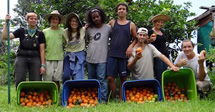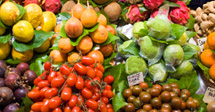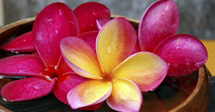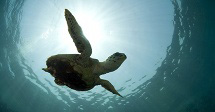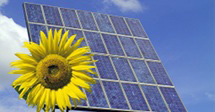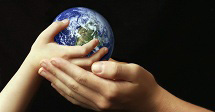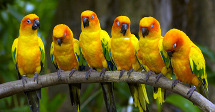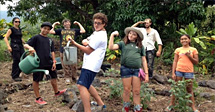Every change we make towards a green lifestyle is a step towards sustainable living. The easiest steps are often a change in behavior, at no monetary cost. When you do vote with your dollar, learn more about the manufacturers you support and select those who are walking the talk of sustainable business practices.
Here are some quick and simple things that cost little or nothing, and may save you money and protect our island environment (see more ideas in our energy section):
Replace regular incandescent light bulbs with compact fluorescent light (CFL) bulbs
CFLs use one-fourth the energy of an old-fashioned incandescent bulb, last longer and are cooler, reducing the need for air conditioning. Changing just one 100-watt bulb to an equivalent 26-watt CFL, based on three hours use per day, can save 81 kWh and up to $24 per year per bulb.
Use fans instead of air conditioners
Two fans, rather than an 8,000 BTU room air conditioner running four hours a day, can save over 1,150 kWh and $345 a year.
Shorten showers, Fix leaky faucets and Flush less often
Cutting just two minutes per shower could save up to 1,533 kWh and $460 per year. A faucet leaking just one drop of hot water per second costs 400 kWh and $120 per year. And flushing the toilet less frequently can save 3-5 gallons per flush (and adding a brick to the tank lessens the water used / electricity to pump your water).
Eat Local and BUY Local to Support Agriculture in your Community and Region
American meals contain products that have traveled an average of 1500 miles to reach our plates. Each mile food travels destroys its freshness, nutrition, and flavor, and raises its negative impact on the environment through higher oil-based transportation costs. Local food tastes great, it is healthier for you and for the planet/ Plus, supporting local farms builds local economic sustainability. Growing your own – the ‘zero-mile’ diet – raises the food’s nutritional value and lowers the transportation impacts even more.
Wash clothes in cold water and Sun/air dry clothes on clothes lines
Switching from Hot Wash/Warm Rinse to the Cold/Cold cycle on a standard, top-loading washing machine for just two loads a week can save 225 kWh and $68 per year. And think about using the greenest clothes dryers in the world – the air and sun!
Eliminate Ghost Loads (phantom load)
Even when turned off, things like hairdryers, cell phone chargers, toasters and televisions use energy. Either keep them unplugged when not in use or use a power strip to conveniently turn off clusters of electronics – like stereo systems, computers (after properly logging off), monitors, printers and chargers for camera batteries, phones and PDAs, all of which use standby power when not in use. Using a power strip to turn off one computer alone can save 50 kWh and $15 per year.
Greener Kitchen Use – Hand wash and air dry dishes and No Peeking
Washing dishes in the sink by hand saves water and electricity. Letting dishes air dry instead of using heated drying on the average dishwasher saves 110 kWh and $33 per year. Limiting how often and how long you open the refrigerator will save electricity and protect the appliance. Also limit opening the oven while cooking or baking to save electricity; protect the appliance and speed up cooking times, too
Drive Less / Fly Less – and support tree planting projects
No matter whether you fly or drive a clunker or a Prius hybrid, driving and flying less saves costs and protects resources be lessening the amount of CO2 you are putting into the air. Carpooling, vanpools, bicycling, consolidating errands – and walking – are great ways to put less miles per person on the road and less CO2 in the air. Vacationing near home versus flying is also a good idea. Supporting projects that plant trees is a way to offset the carbon your travel creates – trees not only clean carbon out of the air through photosynthesis, they also help sequester it in the soil (and bamboo is one of the best carbon sequestering plants around).
Vote with your Dollars – Choose Recycled Paper Products, Non Polluting Cleaning Products, Organic Products, and Bring Your Own Bags
Recycled toilet paper and paper towels save millions of trees every year which in turn helps create more ways to pull carbon out of our atmosphere. Support manufacturers who have stopped using ancient forests to create facial tissue and who use sustainable forests to build furniture. Read the label and avoid phosphates and chlorine in your cleaning products. Organic options exist for many products from near and far. Each organic product we choose lessens our negative impacton the environment. And pick out some fun shopping bags to carry your selections home.
Learn about the real Environmental Impacts of What you Eat
Meatless Mondays offer consumers a way to adjust their diets gradually in ways that improve their health and lower their negative impact on the environment. The David Suzuki Foundation offers information on this growing movement.
Do your own home energy audit and Use ENERGY STAR® appliances
Take the online My Home Energy Check energy survey at ENERGY STAR for a free analysis of where your home energy dollars are going and some tips for possible savings. When it is time to replace or add appliances, look for the ENERGY STAR® symbol on refrigerators, front loading washers, ovens and dishwashers, as well as DVD and VCR players, televisions and home office equipment. Visit ENERGY STAR to learn more. (And be sure to calculate actual energy cost using local Hawaii kwh rates, i.e. $.42 kwh for Hawaii vs $.10 for mainland)
Reduce / Re-use / Recycle – Be sure you’re recycling at home
You can save 2,400 pounds of carbon dioxide a year by recycling half of the waste your household generates. Recycling via reuse also cuts down on negative environmental impacts by limiting the amount of new materials and resources required to manufacture new products. And reducing the sheer volume of what we consume is the very best way to lighten our negative environmentalimpacts. Less really IS More.
Mahalo to the David Suzuki Foundation and HECO for part of the content used on this page



